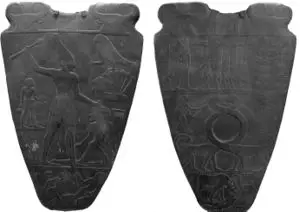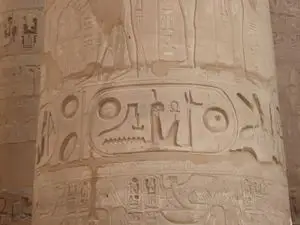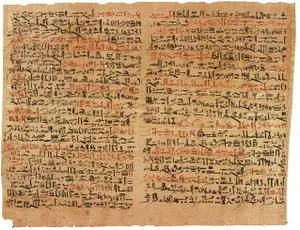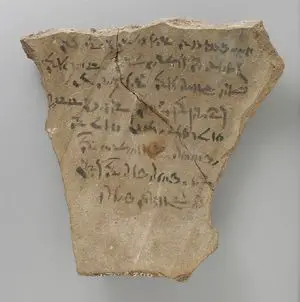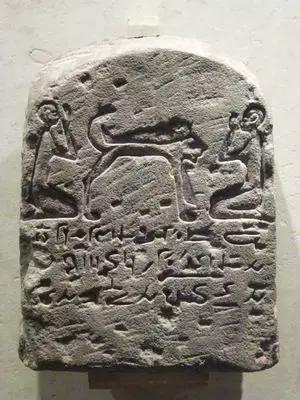How Did Writing Evolve in Ancient Egypt
Ancient Egypt was one of the world’s first two literate societies, having discovered the art/science of writing around the year 3,100 BC, not long after the first scripts were invented in Mesopotamia. But writing in Egypt developed very differently than in Mesopotamia. The initial development of writing in Mesopotamia can be followed along a very gradual yet definite path, while in Egypt, the appearance of the first written texts was somewhat sudden.
The Egyptians quickly mastered writing, and before too long, they used it in several different literary genres. During the period known as the Old Kingdom, Egyptians used writing to convey their ideas about the afterlife in tombs and on monumental inscriptions, and they first began to experiment with what would be known as “literature” in the modern sense. It was during the Middle Kingdom, though, when the Egyptian written language flourished the most, and literary works were written that were dutifully copied for centuries by countless scribes.
By the time of the New Kingdom, the Egyptian written language had evolved to the point where written texts were quite ubiquitous, and alternate forms of writing became common. In addition to the hieroglyphic script, the Egyptians developed cursive scripts known as hieratic and demotic, which were shorthand versions of the hieroglyphic script, used primarily for documents written on papyrus. When the Romans, Byzantines, and Arabs ruled over Egypt, the native forms of the written language eventually died. However, a vestige of them was retained in the liturgical language of Coptic.
Early Egyptian Writing
The earliest forms of documented writing in Egypt are found in the Early Dynastic tombs in the necropolis of Abydos. The oldest example is believed to be a tomb known as “U-j,” which belonged to one of the first Egyptian kings, who ruled just before 3,100 BC. The earliest inscriptions are quite simple, consisting of little more than a few words at most, but the hieroglyphic system of writing appears to have been already fully formed.
The early Egyptian hieroglyphic script consisted of both ideographic and phonetic signs rendered in about 200 signs. [1] The hieroglyphic script could be quite adaptable, which often confounds modern scholars of the language. For instance, the sign that corresponds to a “t” sound was a hieroglyph of a loaf of bread: it could, therefore, be employed phonetically as a “t” sound in a word or as an ideogram to indicate bread or something to do with bread.
Early on the hieroglyphic script was employed for a sign known as the serekh. A serekh was simply one of the king’s many names, written in a square somewhere on a royal monument. Serekhs are found on inscriptions in the tombs and monuments of the kings of the First Dynasty (c. 3,100-2980 BC), the most famous of which is the Narmer Palette, which is believed to be a depiction of Narmer/Menes, the first king of the united Egyptian state. [2] Although stone was the earliest medium on which the Egyptian hieroglyphic script was rendered, it was not the only or even most common.
Monumental inscriptions were carved in the stone of Egyptian temples and on stelae, but the countless administrative documents, as well as literature and other texts, were written on papyrus. Papyrus is a reed that was once quite abundant in Egypt’s Nile Valley and could function as a form of paper. In fact, the modern word “paper” is actually derived from Greek word “papyrus.” In order to utilize papyrus as paper, it simply had to be cut down and rolled out, which allowed it to be used in individual sheets. Scribes could write on either side of a papyrus roll and it could also be used as a palimpsest – if the writer made a mistake, he could simply erase what he wrote and restart. [3]
Writing evolved quickly through the Early Dynastic Period, and by Egypt’s Old Kingdom (c. 2686-2125 BC), the texts were longer, more complex, and much more common. The most developed writings from the Old Kingdom also happened to be the texts that reveal the most about ancient Egyptian religion during the period. Beginning in the Fifth Dynasty (c. 2494-2345 BC), the scribes began inscribing the interiors of the pyramids with religious texts known today as the Pyramid Texts. The Pyramid Texts described the importance of the afterlife as well as the primacy of many of the deities such as Osiris, Re, Isis, and Seth. [4]
But religious inscriptions were not the only important texts created during the Old Kingdom; a genre of writings known as “didactic literature” or “instructions” also became popular. These texts, such as “The Instruction of Ptahhotep,” instruct the reader how to live life as an upstanding, moral and ethical Egyptian. [5] The Pyramid Texts and the didactic texts of the Old Kingdom provided a base for writing and literature in the Middle Kingdom (c. 2055-1650 BC), which is considered by many modern scholars to be the classical age of the ancient Egyptian written language.
Writing in the Middle Kingdom
The Middle Kingdom proved not only to be the high point of the ancient Egyptian language and writing system, but it was also the period when some of the greatest literary works in the civilization were created and new literary genres were invented. The linguistic flowering in the Middle Kingdom was particularly marked during the reign of Senusret I (ruled c. 1919-1875 BC) in the Twelfth Dynasty. The Egyptians expanded on the monumental and religious inscriptions and didactic texts of the Old Kingdom, and they introduced new genres of literature while refining the written language. [6]
Didactic literature continued to be written, but the compositions were longer, more complex, and written better overall. One of the best known Middle Kingdom didactic texts is actually also a fictional tale known as The Eloquent Peasant. It tells the tale of a peasant who was robbed by a noble and although lower in class than his adversary, is quite articulate and able to gain an audience with the pharaoh, where he ultimately wins his case. [7] Other notable fictional prose stories that were first written in the Middle Kingdom include The Shipwrecked Sailor, The Story of Sinuhe, and Three Tales of Wonder.
Middle Kingdom scribes also developed a new literary genre that can be described as historical fiction or pseudo-history. Many of these stories, such as The Prophecies of Neferti are set in the Old Kingdom, where one or more of the main characters warn of the impending chaos of the First Intermediate Period (c. 2181-2055 BC). In The Admonitions of Ipuwer the writer used the effective literary devices of metaphors, similes, and comparisons to demonstrate how hopeless the social and political situation was in the First Intermediate Period. [8] Although the Middle Kingdom collapsed when the Hyksos invaded, the literary base that was created in the Twelfth Dynasty provided an impetus for the Egyptian written language to survive and evolve for the remainder of pharaonic history.
Writing in the New Kingdom and Beyond
Most extant copies of Egyptian papyrus texts that modern scholars study and use in their research are New Kingdom (c. 1550-1069 BC) copies of Middle Kingdom compositions. Although new literary works from the genres discussed above were created, most noteworthy New Kingdom texts were composed on monuments. New Kingdom scribes, though, did create an extensive corpus of historical and “proto-historiographical” texts. Most of the New Kingdom historiographical texts were in the form of king-lists and annals of military campaigns. [9] All genres of Egyptian literature continued to be produced through the Late Period (664 BC-early Christian Era), with historiographical writing becoming even more developed. King-lists continued to be written and a new genre of folk history and pseudo-history formed. [10] One of the most interesting aspects of literature and writing in the New Kingdom, though, was the apparent expansion of overall literacy.
Although the overall literacy rate in ancient Egypt was probably never higher than one percent, a fairly large corpus of written material from the workmen’s village of Deir el-Medina has revealed much about the daily lives of non-noble Egyptians in the Nineteenth and Twentieth dynasties of the New Kingdom. The village was the home to the men and their families who built the tombs in the Valley of the Kings. More than 470 letters, notes, and records written by the workers, which were recorded on papyri and ostraca (pottery sherds) in the hieratic script, demonstrate that the Egyptians’ lived lives not unlike those of the modern world. [11] Although the actual compositions may not approach the level of the literary genres discussed earlier, at least in terms of proper grammar and syntax, they demonstrate that literacy was not just the purview of the nobles.
The Evolution of Script in Ancient Egypt
In addition to the great changes that took place in Egyptian literature over the course of the ancient civilization’s long history, how the language was written, its script, also evolved. The hieroglyphic script was the first script the Egyptians employed to articulate their thoughts in writing and was the most enduring.
Although the hieroglyphic script could be unwieldly due to the details of each character, it was quite adaptable – the texts could be written in any direction. The hieroglyphic text proved to be so durable that the last inscription is dated to the fourth century AD, long after Christianity became the dominant religion of the Nile Valley. [12]
Because the hieroglyphic text could be so cumbersome, a cursive script known as hieratic was developed by 2686 BC. Hieratic was used primarily on papyrus for administrative and literary texts and although a hieratic text could be composed much quicker using it than hieroglyphs, it was only written right to left, which limited its versatility in some ways. [13]
The hieratic script eventually evolved into another cursive script known as demotic. Demotic replaced hieratic in most economic texts by the Twenty-Sixth Dynasty (664-525 BC), but it eventually even began to replace the hieroglyphic script in religious texts and some monuments. Demotic was used into the third century AD when it was all but replaced by Greek. [14] Although all of the Egyptian written scripts that were invented during the pharaonic period were extinct by the early Christian Era, the Coptic language, which is the liturgical language of the Egyptian Orthodox Church, continued to use the native language with a modified Greek script. [15]
Conclusion
The evolution of writing in ancient Egypt was quite complex and featured many theoretical and philosophical branches and forks. Writing appeared somewhat suddenly and then quickly evolved to compromise several different genres. As the different literary genres evolved throughout Egyptian history, so too did the manner in which the language was writing. Egyptian scribes used three different scripts to articulate their language and later adapted the Greek script when they became Christians. Today, scholars are amazed at the number of literary works the Egyptians produced and have yet to uncover all of the nuances of the Egyptian written language.
References
- Jump up ↑ Bard, Kathryn A. “The Emergence of the Egyptian State (c. 3200-2686 BC).” In The Oxford History of Ancient Egypt. Edited by Ian Shaw. (Oxford: Oxford University Press, 2001), p. 78
- Jump up ↑ Bard, p. 81
- Jump up ↑ Shaw, Ian, and Paul Nicholson. The Dictionary of Ancient Egypt. (New York: Henry N. Abrams, 1995), p. 219
- Jump up ↑ Malek, Jaromir. “The Emergence of the Egyptian State (c. 3200-2686 BC).” In The Oxford History of Ancient Egypt. Edited by Ian Shaw. (Oxford: Oxford University Press, 2001), p. 78
- Jump up ↑ Lichtheim, Miriam, ed. Ancient Egyptian Literature. Volume 1, The Old and Middle Kingdoms. (Los Angeles: University of California Press, 2006), pgs. 5-7
- Jump up ↑ Grajetski, Wolfram. The Middle Kingdom of Ancient Egypt. (London: Duckworth, 2009), pgs. 44-45
- Jump up ↑ Lichtheim, pgs. 169-84
- Jump up ↑ Lichtheim, pgs. 149-69
- Jump up ↑ Redford, Donald B. Pharaonic King-Lists, Annals and Day-Books: A Contribution to the Study of the Egyptian Sense of History. (Mississauga, Canada: Benben Publications, 1986), pgs. 18-67
- Jump up ↑ Gozzoli, Roberto B. The Writing of History in Ancient Egypt during the First Millennium BC (ca. 1070-180 BC): Trends and Perspectives. (London: Golden House Publications, 2006).
- Jump up ↑ McDowell, A. G. Village Life in Ancient Egypt: Laundry Lists and Love Songs. (Oxford: Oxford University Press, 2001), p. 7
- Jump up ↑ Shaw and Nicholson, p. 129
- Jump up ↑ Shaw and Nicholson, p. 128
- Jump up ↑ Shaw and Nicholson, p. 83
- Jump up ↑ Shaw and Nicholson, p. 71
